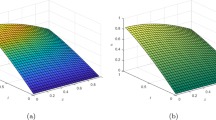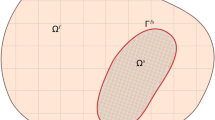Abstract
Smoothed Particle Hydrodynamics (SPH) is a Lagrangian meshless particle method. However, its low accuracy of kernel approximation when particles are distributed disorderly or located near the boundary is an obstacle standing in the way of its wide application. Adopting the Taylor series expansion method and solving the integral equation matrix, the second order kernel approximation method can be obtained, namely K2_SPH, which is discussed in this paper. This method is similar to the Finite Particle Method. With the improvement of kernel approximation, some numerical techniques should be adopted for different types of boundaries, such as a free surface boundary and solid boundary, which are two key numerical techniques of K2_SPH for water wave simulation. This paper gives some numerical results of two dimensional water wave simulations involving standing wave and sloshing tank problems by using K2_SPH. From the comparison of simulation results, the K2_SPH method is more reliable than standard SPH.
Similar content being viewed by others
References
Atluri SN, Shen S (2002). The Meshless Local Petrove-Galerkin (MLPG) method: a simple less-costly alternative to the finite element and boundary element methods. Computer Modeling in Engineering & Sciences, 3(1), 11–52.
Atluri SN, Zhu T (1998). A new meshless local Petrov-Galerkin (MLPG) approach in computational mechanics. Comput. Mech., 22, 117–127.
Belytschko T, Lu YY, Gu L (1994). Element free Galerkin method. Int. J. Num. Meth. Engng., 37, 229–256.
Benz W, Asphaug E (1995). Simulations of brittle solids using smooth particle hydrodynamics. Comput. Phys. Commun., 87, 253–265.
Chen JK, Beraun JE, Jih CJ (1999). An improvement for tensile instability in smoothed particle hydrodynamics. Computational Mechanics, 23, 279–287.
Chen JK, Beraun JE, Jih CJ (1999). A corrective smoothed particle method for boundary value problems in heat conduction. Int. J. Numer. Meth. Engng., 46, 231–252.
Cleary PW, Monaghan JJ (1999). Conduction modeling using smoothed particle hydrodynamics. J. Comput. Phys., 148, 227–264.
Colagrossi A, Landrini M (2003). Numerical simulation of interfacial flow by Smoothed Particle Hydrodynamics. J. Computational Physic., 191, 448–475.
Cummins SJ, Rudman M (1999). An SPH projection method. J. Comput. Phys., 152, 584–607.
Ellero M, Kroger M, Hess S (2002). Viscoelastic flows studied by smoothed particle dynamics. J. Non-Newtonian Fluid Mech., 105, 35–51.
Ellero M, Tanner RI (2005). SPH simulations of transient viscoelastic flows at low Reynolds number. J. Non-Newtonian Fluid Mech., 132, 61–72.
Faltinsen OM (1976). A numerical non-linear method for sloshing in tanks with two dimensional flow. J. Ship Research, 18(4), 224–241.
Fang JN, Owens RG, Tacher L (2006). A numerical study of the SPH method for simulating transient viscoelastic free surface flows. J. Non-Newtonian Fluid Mech., 139, 68–84.
Fang JN, Parriaux A (2008). A regularized lagrangian finite point method for the simulation of incompressible viscous flows. J. Comput. Phys., 227, 8894–8908.
Fang JN, Parriaux A, Rentschler M (2009). Improved SPH methods for simulating free surface flows of viscous fluids. Appl. Numer. Math., 59(2), 251–271.
Gingold RA, Monaghan JJ (1977). Smoothed particle hydrodynamics: theory and application to non-spherical stars. Mon. Not. Roy. Astrou. Soc., 181, 375–389.
Gotoh H, Sakai T (2006). Key issues in the particle method for computation of wave breaking. Coastal Engineering, 53, 171–179.
Johnson GR, Beissel SR (1996). Normalized smoothed functions for sph impact computations. Int. J. Numer. Meth. Eng., 39, 2725–2741.
Koshizuka S, Oka Y (1996). Moving Particle Semi-implicit method for fragmentation of incompressible fluid. Nuclear Science and Engineering, 123, 421–434.
Libersky L D, Petschek A G, Carney T C, et al. (1993). High strain lagrangian hydrodynamics. J. Comput. Phys., 109, 67–75.
Liu GR, Liu MB (2003). Smoothed Particle Hydrodynamics-a Meshfree particle method. World Scientific
Liu GR, Xu XG (2008). A gradient smoothing method (GSM) for fluid dynamics problems. Int. J. Numer. Methods Fluids, 58, 1101–1133.
Liu MB, Liu GR (2006). Restoring particle consistency in smoothed particle hydrodynamics. Applied Numerical Mathematics, 56, 9–36.
Liu MB, Liu GR (2010). Smoothed particle hydrodynamics (SPH): an overview and recent developments. Arch. Comput. Methods Eng., 17, 25–76.
Liu MB, Liu GR, Lam KY (2002). Investigations into water mitigations using a meshless particle method. Shock waves, 12(3), 181–195.
Liu MB, Liu GR, Lam KY (2003). Smoothed particle hydrodynamics for numerical simulation of underwater explosion. Comput. Mech., 30(2), 106–118.
Liu MB, Liu GR, Zong Z (2000). Numerical simulation of underwater explosion by SPH. Advances in Computational Engineering & Science, 1, 1475–1480.
Liu MB, Xie WP, Liu GR (2005). Modeling incompressible flows using a finite particle method. Appl. Math. Model., 29(12), 1252–1270.
Liu WK, Chen Y, Jun S et al. (1996). Overview and application of the reproducing kernel particle methods. Arch. Comput. Methods Eng.: State of the Art Rev., 3, 3–80.
Liu WK, Chen Y, Uras RA (1996). Generalized multiple scale reproducing kernel particle methods. Computer Methods in Applied Mechanics and Engineering, 139, 91–157.
Liu WK, Jun S, Li SF (1995). Reproducing kernel particle methods for structural dynamics. Int. J. Numer. Meth. Engng., 38, 1655–1679.
Liu WK, Jun S, Sihling DT (1997). Multiresolution reproducing kernel particle method for computational fluid dynamics. Int. J. Numer. Meth. Fluids., 24, 1391–1415.
Liu WK, Jun S, Zhang YF (1995). Reproducing kernel particle methods. Int J. Numer Methods Eng., 20, 1081–1106.
Lo Edmond YM, Shao SD (2002). Simulation of near-shore solitary wave mechanics by an incompressible SPH method. Applied Ocean research, 24, 275–286.
Lucy LB (1977). A numerical approach to the testing of the fission hypothesis. The Astron. J., 82(12), 1013–1024.
Ma QW (2005). Meshless local Petrov-Galerin method for two dimensional nonlinear water wave problems. J. Compu. Phys., 205(2), 611–625.
Ma QW (2005). MLPG method based on rankine source solution for simulating nonlinear water waves. Computer Modelling in Engineering & Sciences, 9(2), 193–209.
Ma QW (2008). A new Meshless interpolation scheme for MLPG_R method. Computer Modeling in Engineering & Sciences, 23(2), 75–89.
Ma QW, Zhou J (2009). MLPG_R method for numerical simulation of 2D breaking waves. Computer Modeling in Engineering & Sciences, 43(3), 277–304.
Maveyraud C, Benz W, Sornette A (1999). Solid friction at high sliding velocities: an explicit three-dimensional dynamical smoothed particle hydrodynamics approach. J. Geophys. Res., 104, 28769–28788.
Monaghan JJ (1988). An introduction to SPH. Comput. Phys. Comm., 48, 89–96.
Monaghan JJ (1994). Simulation Free Surface Flows with SPH, J. Compu. Phys., 110(4), 399–406.
Monaghan JJ, Kocharyan A (1995). SPH simulation of multi-phase flow. Comput. Phys. Commun., 87, 225–235.
Morris JP, Fox PJ, Zhu Y (1997). Modeling low Reynolds number incompressible flows using SPH. J. Comput. Phys., 136, 214–226.
Nayroles B, Touzot G, Vilon P (1992). Generalizing the finite element method: diffuse approximation and diffuse elements. Comput. Mech., 10, 307–318.
Onate E, Idelsohn S, Zinnkinewicz OC (1996). A finite point method in computational mechanics: Applications to convective transport and fluid flow. Int. J. Num. Meth. Engng., 39, 3839–3866.
Shao SD (2009). Incompressible SPH simulation of water entry of a free-falling object. Int. J. Numer Methods Fluids, 59(1), 91–115.
Shao SD, Ji CM, Graham DI (2006). Simulation of wave overtopping by an incompressible SPH model. Coast Eng., 53(9), 723–735.
Shao S, Lo Edmond YM (2003). Incompressible SPH method for simulating Newtonian and non-Newtonian flows with a free surface. Adv. Water Resour., 26(7), 787–800.
Takeda H, Miyama SM, Sekiya M (1994). Numerical simulation of viscous flow by smoothed particle hydrodynamics. Prog. Theor. Phys., 92(5), 939–959.
Wu G.X (2007). Second order resonance of sloshing in a tank. Ocean Engineering, 34, 2345–2349.
Xu HH, Ha DM, Soon CE (2010). A SPH model with C1 particle consistency. 5th International SPHERIC Workshop, Manchester, UK, 194–200.
Zhang GM, Batra RC (2007). Wave propagation in functionally graded materials by modified smoothed particle hydrodynamics (MSPH) method. J. Comput. Phys., 222, 374–390.
Zhang GM, Batra RC (2008). Modified smoothed particle hydrodynamics (MSPH) basis functions for meshless method, and their application to axisymmetric Taylor impact test. J. Comput. Phys., 227, 1962–1981.
Zheng X, Duan WY (2008). Study on the precision of second order algorithm for smoothed particle hydrodynamics. Advances in Water Science, 19(6), 86–92. (in Chinese)
Zheng X, Duan WY (2010). Numerical simulation of dam breaking using smoothed particle hydrodynamics and viscosity behavior. J. Marine Sci. Appl., 9(1), 34–41.
Zheng X, Duan WY, Ma QW (2010). Comparison of improved meshless interpolation schemes for SPH method and accuracy analysis. J. Marine Sci. Appli., 9(3), 223–230.
Zou ZL (2005). Water wave theories and their applications. Science Press, Beijing.
Author information
Authors and Affiliations
Corresponding author
Additional information
Foundation item: Supported by the National Natural Science Fundation of China (51009034), Foundational Research Funds of Harbin Engineering University (HEUFT05023, HEUFP05001), Foundational Research Funds for the central Universities (HEUCF100102) and 111 program (B07019).
Zhenhong Hu was born in 1976. She is a lecturer at Harbin Engineering University. Her current research interests include hydrodynamics and the meshless computation method.
Xing Zheng was born in 1980. He is a lecturer at Harbin Engineering University. His current research interests include the meshless computation method and hydrodynamics.
Wenyang Duan was born in 1967. He is a professor at Harbin Engineering University. His current research interests include marine hydrodynamics, time domain BEM, and meshless particle methods.
Qingwei Ma was born in 1955. He is a professor at the City University of London. His current research interests include meshless particle method algorithms and the nonlinear finite element method for hydrodynamics simulation.
Rights and permissions
About this article
Cite this article
Hu, Z., Zheng, X., Duan, W. et al. K2_SPH method and its application for 2-D water wave simulation. J. Marine. Sci. Appl. 10, 399–412 (2011). https://doi.org/10.1007/s11804-011-1085-y
Received:
Published:
Issue Date:
DOI: https://doi.org/10.1007/s11804-011-1085-y




